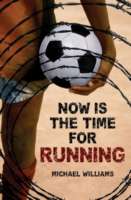by Carmen M. Martínez-Roldán, Columbia University

This week we continue with the focus on the use of international children’s and adolescent literature in classrooms. Today I share an interview with Prof. Deanna Day from Washington State University at Vancouver, who shares how she incorporates international literature in her reading class. In her responses, she focuses on books on immigration.
Carmen: How do you integrate international literature in your classes? In which class you have used it?
Deanna: Last spring I taught a reading methods course for preservice teachers and we read immigration books. These were the titles they chose from: Inside Out & Back Again (Lai, 2011), All the Broken Pieces (Burg, 2009), Home of the Brave (Applegate, 2007), Now Is the Time forRunning (Williams, 2011), City of Orphans (Avi, 2011) and Crossing the Wire (Hobbs, 2007). I am enjoying using these immigration books.
Carmen: Do you have a favorite book?
Deanna: Immigration is definitely a topic/theme/issue that I am passionate about and collect books on this theme. My all time favorite immigration book is The Circuit by Francisco Jiménez. I have used this book with 4th graders all the way to graduate students. Francisco is an amazing writer and professor. I interviewed him and wrote an article about his books/life: Day, D. (2006). Persevering with hope: Francisco Jiménez. Language Arts, 83(3), 266-270.
Carmen: Who are your students?
Deanna: My students are undergraduate pre-service teachers, 90% of them are from European American backgrounds.
Carmen: How have you engaged your students with the literature?
Deanna: We first view a slide show of approximately 50 images depicting immigration today; Then we discuss the immigration novels in small group literature circles. Students share sticky notes and talk about the novels; Then students create a multimodal powerpoint slide on their individual books. In their slide they include images, quotes, thoughts/feelings, connections, internet links, music, etc about their books. These multimodal slides are uploaded to our course management system and everyone views and comments on the slides; Next we read some poetry from immigrants and view some YouTube videos that show current political opinions about immigration; If time allows we read and discuss picture books around the theme of immigration (students are always surprised that this topic is in picture books because they think it is too difficult for young children); We always close with critically thinking about immigration and writing about our experience. I have used Bill Bigelow’s book The Line between Us (2006, Rethinking Schools) for ideas a couple of times. I also collect newspaper articles about immigration that students read too.
Carmen: How have your students’ responded to the literature?
Deanna: Usually only 1 student out of 30+ has experienced immigration so therefore reading novels around immigration is very eye opening for them. Last year the small group that read Now Is the Time for Running (Williams, 2011) learned that immigration is occurring everywhere in the world, not just in the United States. They were impressed with Williams’ writing and all said they couldn’t put the book down. After the small group book talked the novel to our class, more than 1/3 of the students borrowed the book to read on their own.
Inside Out & Back Again (Lai, 2011) was also a popular novel that spread through the classroom. For many preservice teachers this was the first verse novel that they had ever read. Some noted that the verse novels would be ideal for students who might be hesitant about reading novels. The college students found the short length, condensed language and writing form a lot of fun to read. Plus this novel really touched them.
Carmen: Any special advice to other teachers/instructors who want to start integrating international literature in their classrooms?
Deanna: Using children’s literature in reading methods courses is critical because some pre-service teachers think the only way to teach reading is through a textbook, anthology or basal reader. This is what they experienced in their K-8 education or is what they see in many of the classrooms they observe or volunteer in. Each week I set up our class so that pre-service teachers experience reading and writing workshop, read and discuss professional articles about using real children’s literature to teach reading and watch video clips of actual classrooms using children’s literature. At the same time students use digital technology to support and enhance children’s literature and reading. For example, every student keeps a log of the books they read during reading workshop on Good Reads (a social networking site for people who love books). Students respond to what they read using Glogster, Strip Designer, Puppet Pals, Doodle Buddy or other 2.0 tools. I wish I used more international literature in my reading methods courses and continue to think about how to do this more often.
After learning about Deanna’s experience using books on immigration, I want to invite you to share your experiences.
Have you read or used with your students Inside Out & Back Again? How did the students respond to this novel? How did you respond to the book? Is there any special title that you have used with a focus on immigration?
Journey through Worlds of Words during our open reading hours: Monday-Friday, 9 a.m. to 5 p.m. and Saturday, 9 a.m. to 1 p.m. To view our complete offerings of WOW Currents, please visit archival stream.
- Themes: Carmen M. Martínez-Roldán
- Descriptors: Books & Resources, Student Connections, WOW Currents
